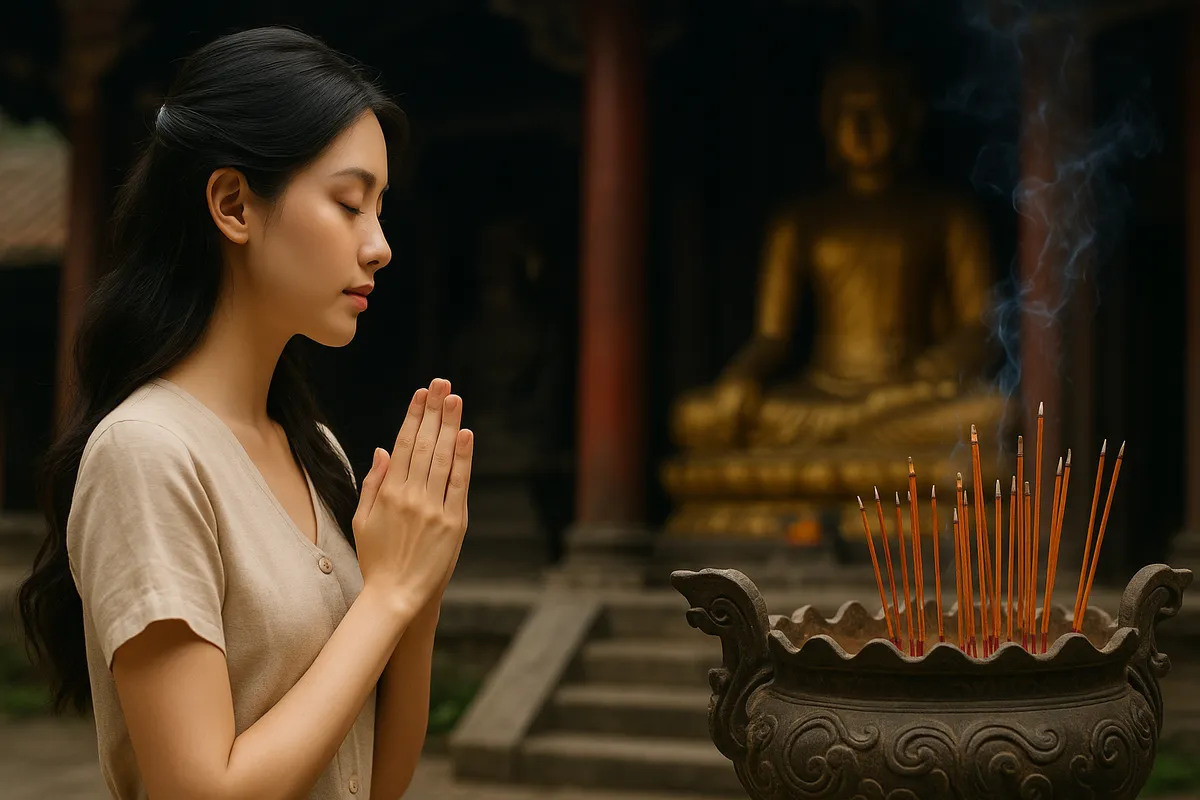Civilized behavior helps preserve the sacredness of temples
- Saturday, May 17, 2025, 09:51 (GMT+7)
Civilized behavior helps preserve the sacredness of temples
A temple nestled within the mountains, its bell echoing through the mist of incense smoke. People step slowly through the three-arched gate, their eyes calm and contemplative. But within that sacred space, laughter suddenly erupts, a phone rings loud and clear, and the silence is shattered. This is not a story of one place alone. Temples, shrines, and pagodas across the country continue to bear witness to the lack of mindfulness displayed by many who come to worship.
Plenty arrive with good intentions in their hearts, but unknowingly leave behind acts that feel out of place. A young person in short pants snapping photos in front of a Buddha statue. A group of tourists laughing loudly in the main hall. A family laying out snacks on temple steps and leaving trash behind after the ritual. These scenes have been witnessed in revered destinations such as Yen Tu, Bai Dinh, Phu Tay Ho, and Truc Lam Zen Monastery. Actions that seem small in the moment can carry significant consequences, stripping away the serenity and reverence that define sacred spaces.
A common cause behind such behavior is the mindset that “everyone else is doing it.” One person sees others taking photos inside the altar room and follows suit. Another hears someone speaking loudly and forgets the need for quiet. This domino effect makes improper conduct feel normal, while respectful behavior becomes rare.
Clothing is one of the first things that calls for attention. Many ancient temples display signs requesting modest dress, yet few enforce the rule. Spaghetti straps, short skirts, and tight outfits often disrupt the solemn ambiance. Some people may act unintentionally, others deliberately, but the impact is the same. A simple tip with great effect is to keep a light scarf or jacket in your bag. Whether male or female, lightly covering the shoulders or wearing an outer layer over short garments is a subtle yet powerful way to show respect. In regions like the Northwest, Central Highlands, or Central Vietnam, additional customs may include removing shoes before entering the main sanctuary, avoiding black clothing on important days, or never turning your back toward a sacred statue when taking photos.
Inside temples, many people recite prayers aloud in hopes of being heard, or read from their phones without muting the sound, disrupting the atmosphere of stillness. This behavior can annoy others and break the sacred rhythm. If a reference is truly needed, consider reading quietly or using a single earbud. Better yet, write the prayer down on a small slip of paper. It shows sincerity and avoids disturbing those around you.
One particularly criticized act is taking photos without consideration. Some raise their phones to shoot nonstop, even posing for selfies right in front of altars. These images often trigger backlash when shared on social media. Sacred places are not backdrops for performative snapshots. If you wish to keep a memory, take photos in temple courtyards, near the entrance gates, or within meditation gardens, and always avoid scenes with altars, offering tables, or areas where rituals are being performed. A beautiful photo means nothing if it is taken with the wrong attitude.
Many visitors have recounted moments of discomfort during festivals and holidays, witnessing crowds pushing and shoving at famous temples. People carrying offerings must squeeze through throngs to reach the altar. Others try to cut in front, desperate to be first. Nobody wants to wait in line, yet everyone contributes to the chaos. A practical solution is to visit during off-peak hours or on quieter days if the visit is not time-sensitive. More importantly, maintain a calm mindset, you are there to seek peace, not to win a race for blessings.
Another widely noted concern is the careless placement of small bills on statues, altar steps, or directly into the hands of sacred figures. Some believe this brings good luck, but it often damages the surface of the statues, creates stains, and ruins the aesthetic of the space. It is far more respectful to place offerings in designated donation boxes or gently into prearranged baskets. A sacred place should never become a playground for misguided habits.
One often overlooked but deeply important element is the way we treat the caretakers of temples and shrines. These are the people who maintain the shared space, often working long hours to answer repetitive questions or correct inappropriate behavior. A simple thank you, a kind look, or even just refraining from snapping at them out of impatience is a sign of maturity. Worship is not a private act but a shared cultural ritual. Every visitor is part of a collective effort to preserve spiritual identity.
Waste is another lingering issue. Candy wrappers, water bottles, burnt offerings, even incense ashes, all contribute to disorder. Many people think, “It’s just a little,” but hundreds of such little things build up quickly. Carry a small bag for your trash, burn votive papers only in designated areas, and avoid scattering rice or salt randomly. Small gestures like these have a powerful impact.
Another tip that few people consider, but which leaves a strong impression, is learning a few local greetings or phrases before visiting a place of worship in ethnic minority regions. Whether among the Dao, Thai, Cham, or Khmer people, a simple respectful greeting in their native language or a small gesture like folding your hands can go a long way in honoring the local culture. It shows humility, curiosity, and earns goodwill from locals and fellow travelers alike.
In the end, the most important thing about visiting a sacred site is not how elaborate the offerings are or how many rituals are performed. It is about maintaining a pure heart, slowing down, and grounding yourself in the moment. Respectful behavior does not come from knowing a lot. It comes from being mindful of where you are, who you are among, and the role you play as a visitor.
Worship is not just a spiritual journey. It is a reflection of one’s values. And sometimes, the way someone behaves at the gates of a temple reveals more about their life philosophy than words ever could.

 CHECKIN.VN
CHECKIN.VN








Share on